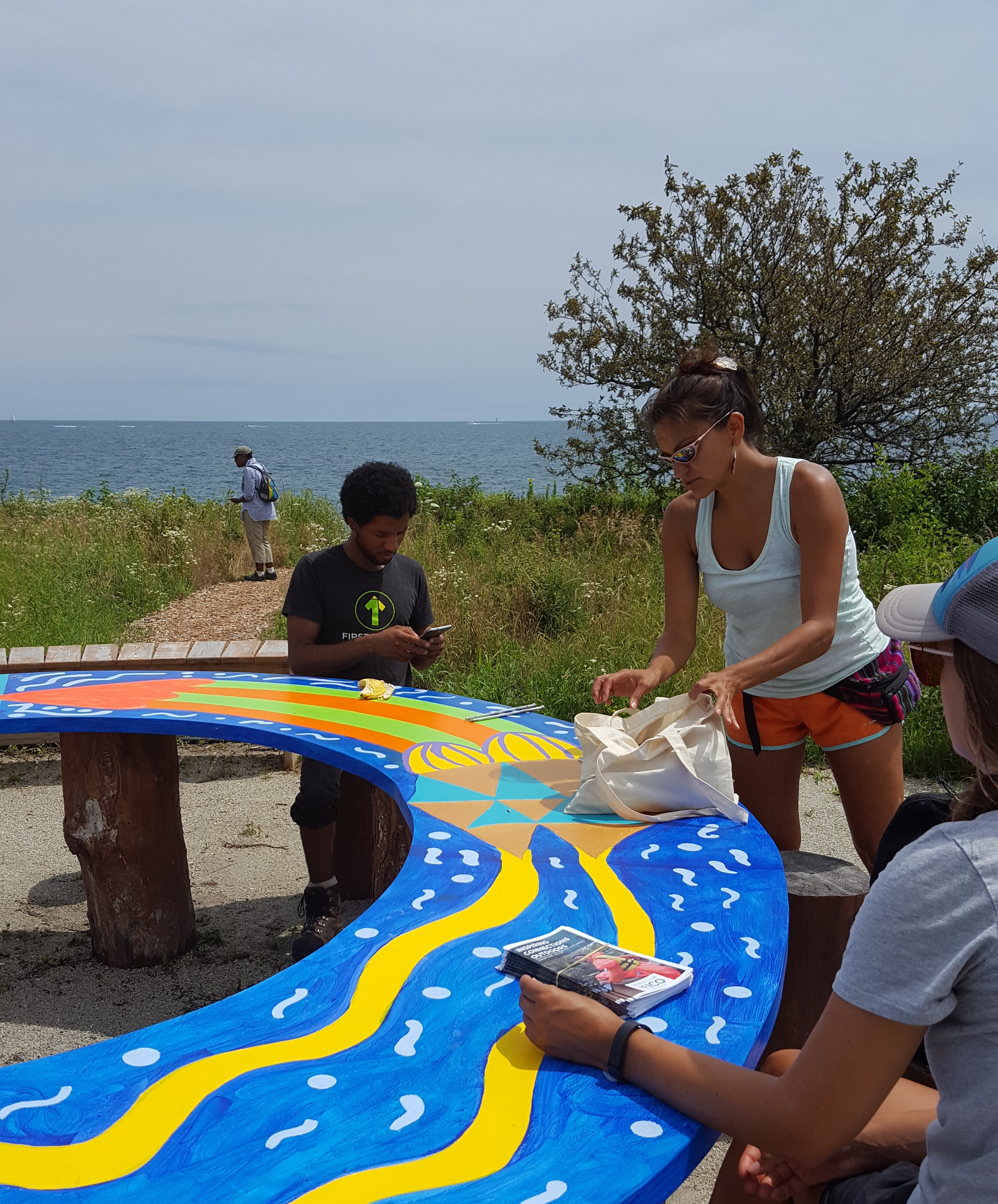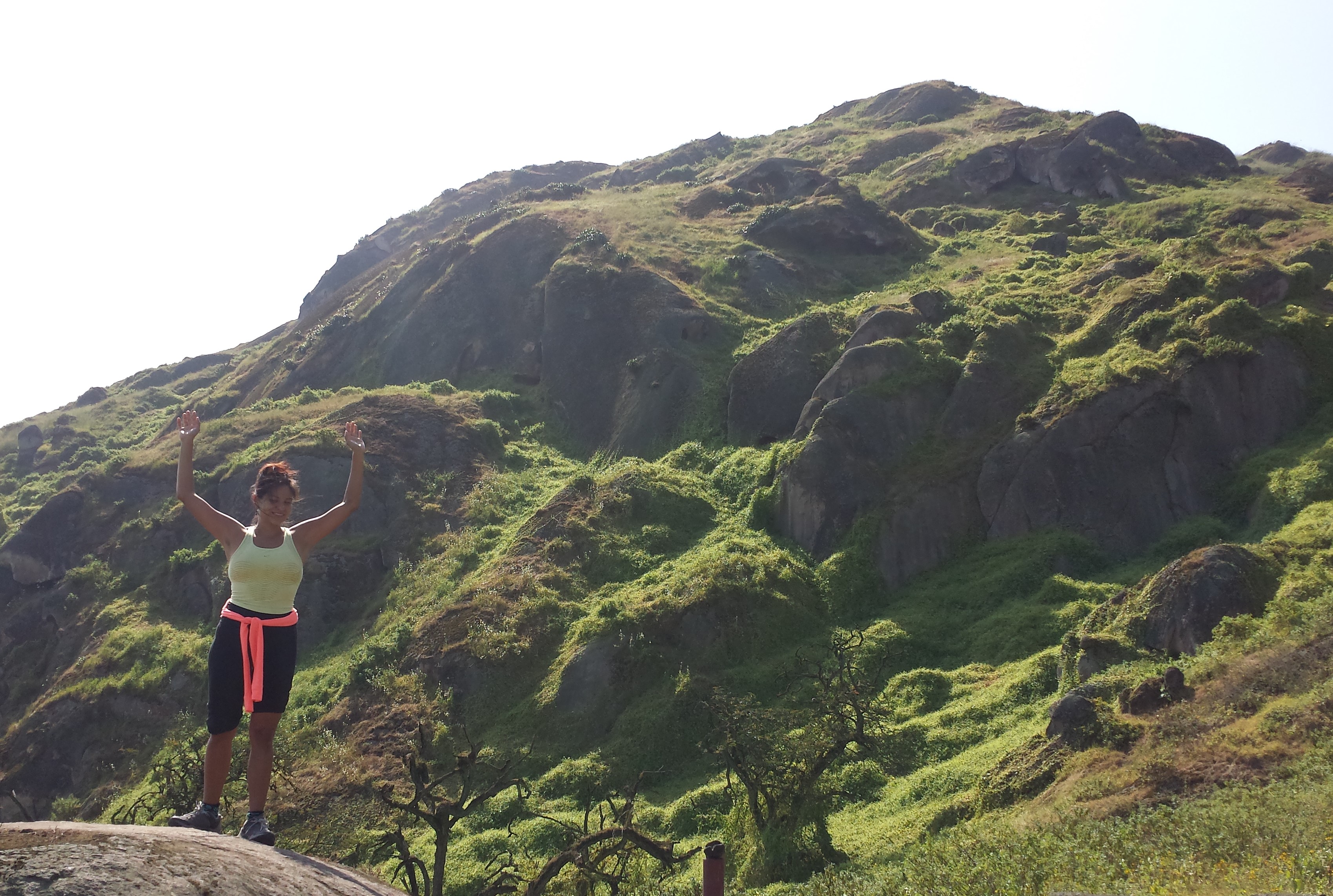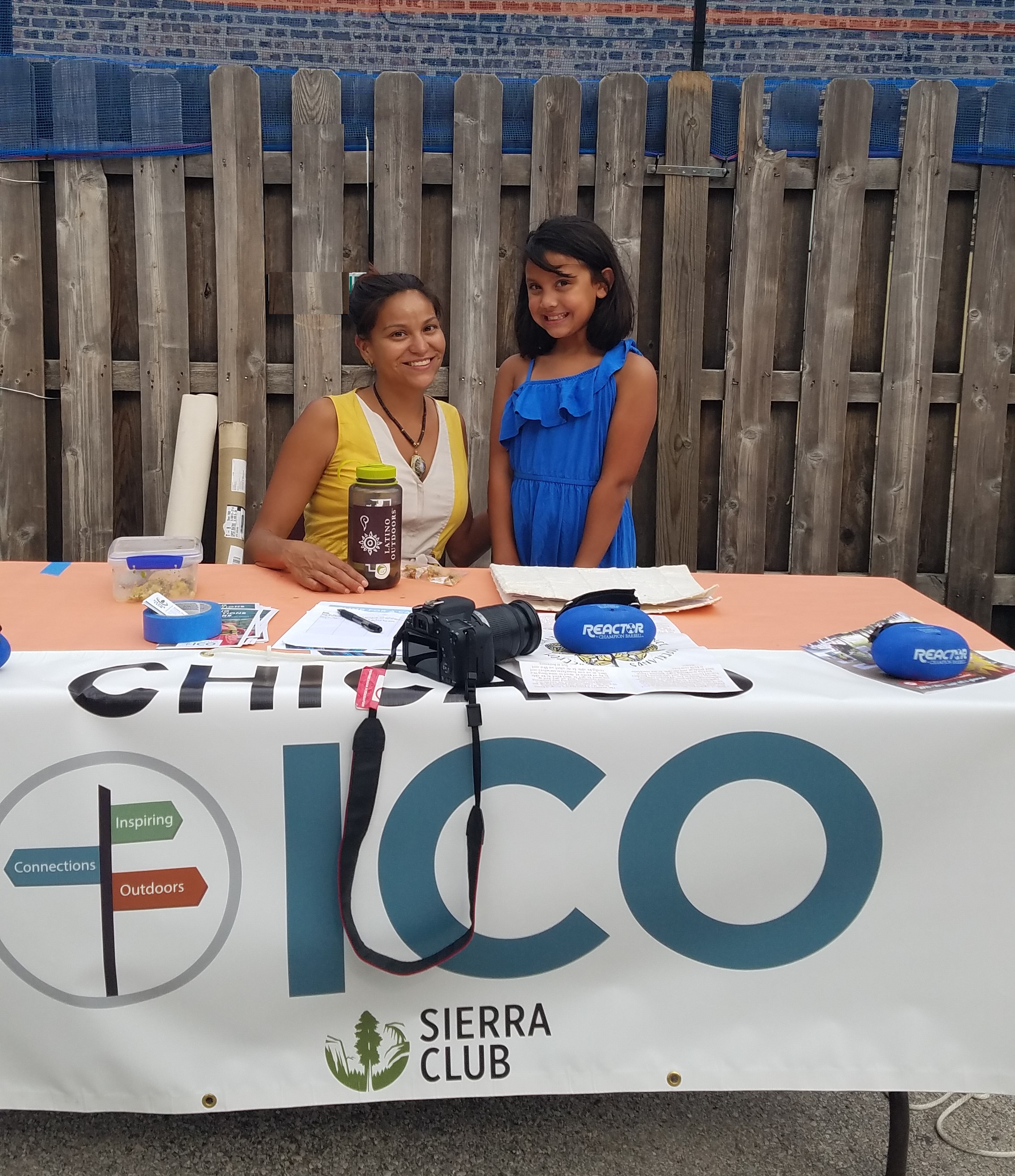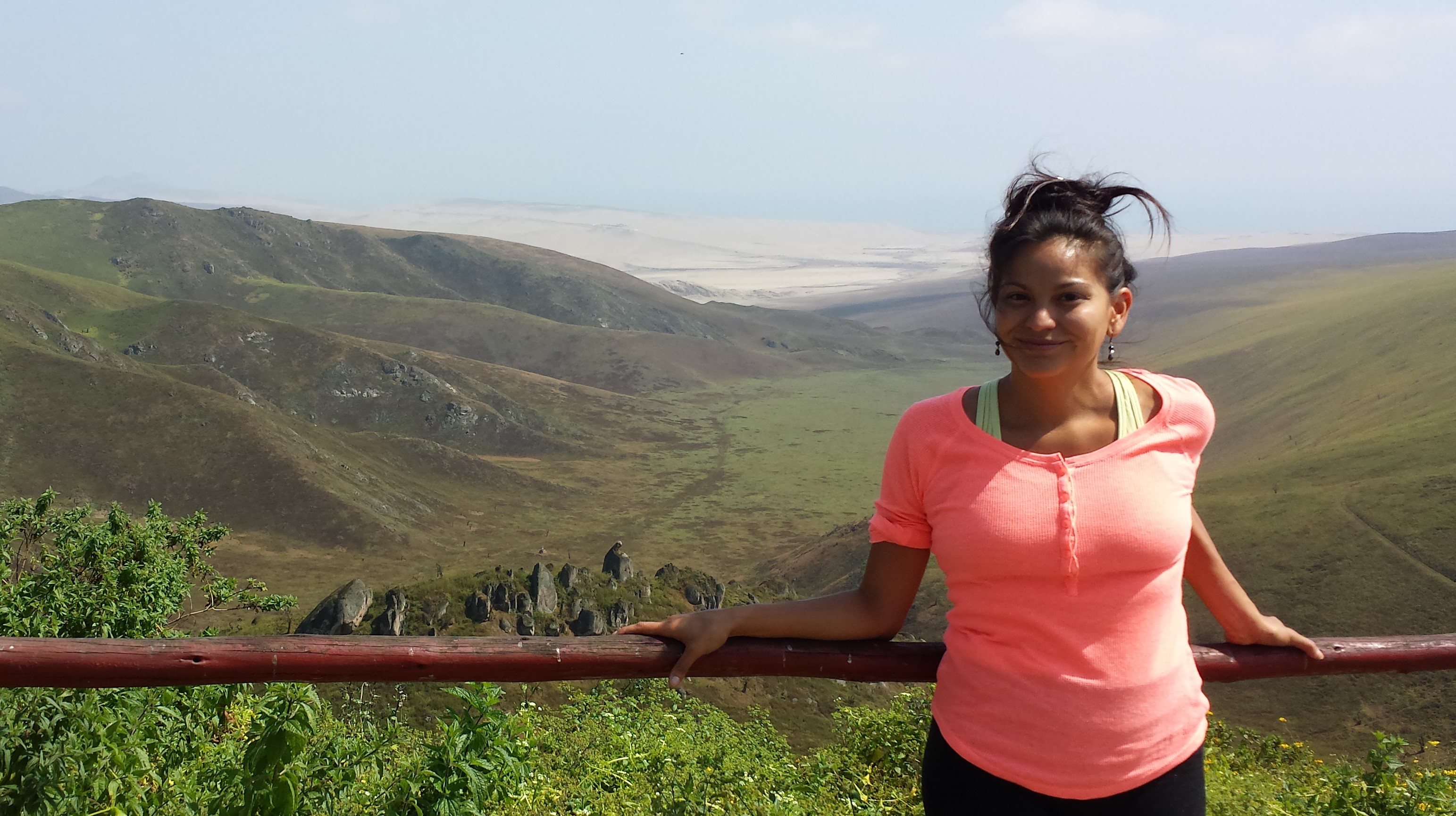On sun-baked, summer days in Chicago city-dwellers (travelers and natives alike) flock to Lake Michigan. Signs of life dot the lakefront in many forms--picnics, bike rides, weddings, soccer games.
Meetings, not so much.
The morning is clear and the sun is high when Katty Regalado addresses those that have arrived at Caracol, one of Chicago’s 5 community-designed Gathering Spaces recently created along the lake. She sits at the spiraled table that hints at the space’s name (caracol means “snail” or “shell” in Spanish), hands resting on its bright colors. As Chicago’s Inspiring Connections Outdoors Coordinator she is always exploring meaningful, inventive ways to engage a wide range of prospective ICO participants, volunteers, and collaborators--this meeting is no exception.
Katty begins with an excerpt from an essay written by Susan Powers, Chicago author and member of the Standing Rock Sioux Tribe.
“‘I learned to squint at the 1967 shoreline until I had carved away the structures and roads built on landfill and could imagine the lake and its city as my mother found them in 1942 when she arrived in Chicago. I say ‘the lake and its city’ rather than ‘the city and its lake’ because my mother taught me another secret: The city of Chicago belongs to Lake Michigan.’”
The small group clustered at the table processes Powers’ words quietly, rolling them around. Some nod, some hum. All reflect.
Together the event’s location and introductory message embody the goal that Katty seeks to meet in her work with ICO: to invite and to lift up new perspectives, voices, and ways of framing one’s relationship to nature.

“Both the challenge and the aspiration is to make space for all kinds of narratives in environmentalism,” Katty explains. “We have to figure out how to expand our definitions of what it means to be outdoors and what it means to be an environmentalist so that everyone feels welcome and everyone has a voice.”
At present, most environmental communities do not represent the diversity of thought, culture, racial background, economic background, or language of the country’s population. And without that representation, both green spaces and green communities (our networks of environmentally-minded people and organizations) will suffer.
Providing marginalized communities with access to green space and opportunities for outings is an important part of the solution, and as a seasoned environmental educator and organizer Katty has seen the benefit of programming that works to get people outside.
However, these tangible efforts at inclusion in physical space must be accompanied by efforts at inclusion in a less concrete space: our minds. Katty explains that the second, equally crucial part of the solution to the lack of diversity in environmental communities lies in evaluating the stories, symbols, language, and values that direct our interactions with each other and with the environment.
“Everyone comes to the table with different stories. Life doesn’t exist in a vacuum, and that’s something that’s really important to remember when trying to engage people. No one shows up as a blank slate. There is a story.”
Katty believes that there is great potential for personal experiences and cultural lenses to strengthen engagement efforts and outreach with communities commonly excluded from participation. Part of the reason that she is so passionate is because she understands the role that her own experience has played in her relationship to the environment.
“There was no “Eco Ambassador” program or anything like that when I was growing up. My grandmother was the one that influenced me. She passed on a knowledge and a relationship to nature that was influenced by her own experience working the land in Peru. For me being outdoors is about accessing that relationship, accessing ancestral ties and something beyond myself. It centers and grounds me.”

Walks in the park with her herbalist grandmother pointing out plants and their uses in Spanish, celebrations with Chicago’s Peruvian community in forest preserves, trips to the Indiana Dunes with her father--these things shaped her brand of environmentalism.
Katty’s desire to understand the role of culture and personal experience in developing one’s understanding of their environment led her to work as a research assistant at the American Indian Center in Chicago. While helping with a project exploring the cultural context of learning and indigenous knowledge, she discovered that although we don’t often realize it, “everything is embedded in culture” from an individual’s relationship to their environment to entire systems of thought (like science or language). “[We need to acknowledge] that we all show up with these belief systems and perceptions, and [we need to] ask ourselves what are the implications [of our] messaging in relation to the environment. Cultural perspectives shape the way we see and do things.”
Through the project she witnessed the way in which indigenous scientific knowledge and Western scientific knowledge each carry the influence of their respective cultural contexts, the way that classrooms teaching solely Western scientific knowledge to indigenous children failed to provide them with the knowledge most relevant to their day-to-day life, and the way that one set of knowledge is routinely, unfairly prioritized over another.
Katty finds parallels between the ideological, cultural struggles that play out in these classrooms and the ideological, cultural struggles that play out in environmental communities. It is rare that she sees her own experiences, perspectives, or concerns reflected in the predominant messaging and actions of large environmental organizations, which at times become removed from the social, cultural components of their work or at times prioritize one way of interacting with the environment (land conservation and backpacking, for instance) over another (environmental justice initiatives and forest preserve barbeques). Katty stresses that “there is space for both.”
Broadening the scope of experiences, cultural perspectives, and stories accepted and shared by the environmental community at large will make these spaces themselves less impenetrable, more inclusive, and consequently more diverse.
Adopting new ideas and perspectives in the environmental movement, acknowledging the varied spaces for interacting with the outdoors. It might seem like a tall order, but it’s possible. Large environmental communities, Sierra Club included, have done it before.
About 60 years ago, when outdoor recreation reached new levels of popularity, environmentalists were faced with a problem: green spaces (National Parks, local campgrounds, and forest preserves) were suffering from pollution and overcrowding. The solution? Introduce basic stewardship principles to the public in relatable ways with phrases like “Take only pictures, leave only footprints” and with figures like Smokey the Bear. It was brilliant, creating messages that would teach outdoor enthusiasts how to be responsible campers, hikers, boaters, and more. It was also effective. These days stewardship is a more solid fixture in outdoor appreciation, for which we can all be thankful.
So here we are again, faced with a problem. The only difference is that now the stewardship that we have to encourage will include not only the care and keeping of green spaces, but green communities as well.
At the moment green communities are splintered along cultural, racial, and political lines. Many large environmental organizations in the U.S. are predominantly led and staffed by white individuals; many of these leaders share certain background experiences, and may not have strong ties to minority-run, grassroots organizations. Misunderstandings, miscommunication, and myths further divide these fragments of green communities and further disadvantage the people that the movement should aim to protect. Fixing these problems calls for mindfulness and respect, open and honest communication, and a unified set of goals--all of which require a desire to perceive the world with lenses that differ from your own, a desire to acknowledge culture as a powerful force, and a desire to collaborate and exchange ideas.
With this information in mind Katty Regalado has devised a plan.

She is currently in the process of developing a youth leadership program for Chicago’s ICO group--one that will train young people to co-lead outings themselves and to plan programming relevant to their interests and the interests of their communities. Her goals for the existing partnerships with youth groups and schools are just as exciting: she intends to not only incorporate participants’ input in the program planning process but to also “integrate wellness, social and emotional learning, and art-making and other culturally resonant activities that promote exploration of their personal relationships [with the natural world]”.
These steps toward facilitating equity, inclusivity, and environmental engagement are essential. Achieving widespread change is not going to be easy, but with people like Katty involved it’s absolutely possible.
____________________________________________________________________________________
Inspiring Connections Outdoors contributes to the creation of more equitable outdoor environments by connecting youth from communities historically marginalized in the outdoor and environmental movement with outdoor activities that promote wellness, connection, and leadership. If you’d like to be part of the ICO family you can find information about how to get involved here or you can contact the team via email (ChicagoICO@gmail.com). Follow all of the adventures on Instagram or Facebook!
